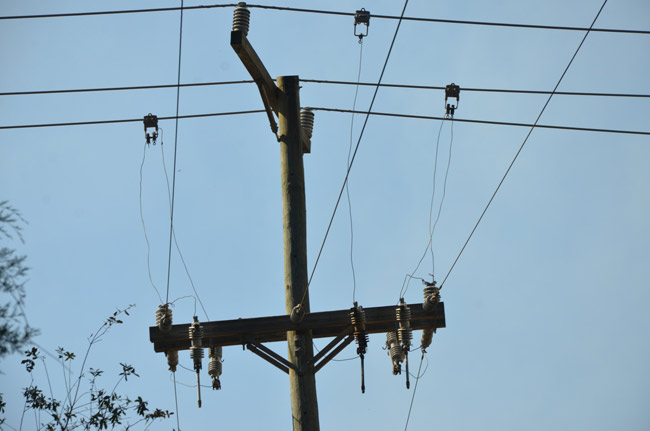
Florida Power & Light customers would see increases in monthly bills starting in May because of higher-than-expected natural gas costs, under a recommendation issued Friday by staff members of the state Public Service Commission. FPL is seeking to collect an additional $302.5 million related to costs of fuel for its power plants.
FPL powers the electricity needs of almost all homes and businesses in Flagler County.
Each fall, the Public Service Commission approves estimated utility fuel costs, which are then passed on to customers. But utilities can return to the commission for increases if fuel costs are substantially higher than projected. The commission is slated to take up FPL’s request April 1.
The utility proposed beginning to collect the additional money in April, but the recommendation from commission staff members said the change should start May 1 to provide more time to give notice to customers. As a benchmark, the utility industry typically uses monthly bills of residential customers who consume 1,000 kilowatt hours of electricity. Currently, such FPL customers pay $99.05 a month. Under the commission staff recommendation, that amount would go to $103.02 in May and continue through December.





























Shelly says
If we supplied our own fuel here in the U.S. we wouldn’t be reading this article right now. Gas prices would be way lower.
FlaglerLive says
The United States is the world’s leading oil producer, at 19.47 million barrels per day, almost twice the rate of second-place Saudi Arabia and Russia.
Ray W. says
According to the U.S. Energy Information System (IEA), we produced an average of 11.06 million barrels of crude oil per day in December, 2020. We consumed just under 20 million barrels of petroleum products per day.
In December, 2008, the last full month of W’s administration, we produced an average of 5.1 million barrels of crude oil per day. A new fracking compound had been developed by a chemist; it, plus advances in horizontal drilling methods, lowered the cost of fracking to a point where the resulting energy boom could help drive an unprecedented period of economic growth. According to the IEA, by April 2015, we were producing an average of 9.7 million barrels of crude oil per day, a 90% increase in less than 7 years.
For better or worse, low cost energy has fueled America’s long period of economic growth and will continue to do so. Now that advances in utility-grade solar cell technology and much more efficient wind turbine design has driven down the cost of electric power generation to levels below the most advanced gas turbine generating plants, we need to develop an American wind and solar production system, for the simple reason that it provides cheaper electricity for our homes and businesses. One reason why Hillary Clinton famously claimed that the coal industry was obsolete was permitting. When American growth expanded after WWII, we built numerous coal-fired electrical generating facilities. They came with a 60-year expiration plan, because the infrastructure such as high-pressure steam pipe fittings were certified to last for 60 years. Power companies must either rebuild the entire high-pressure pipe fitting infrastructure of the coal plant or build a brand-new generating plant. That is what FPL and Duke Power have been doing in Florida and other companies have been doing around the world. When an old coal-fired facility had to be shut down or rebuilt, they decided to rebuild with gas-turbine generator systems. Now, as anyone can read, FPL is asking for money from its customers to build new solar power facilities.
Sherry is focusing on the result of high gas prices, not the cause. Gas prices are high primarily because there is a short-term shortage of gasoline. Texas has almost 25% of America’s refinery capacity. When Texas refineries lost electrical power due to lack of winterized facilities, we simply lost the capacity to make enough gasoline to supply all our needs. Now that most of the Texas refineries are producing gasoline again, supply will eventually be back to normal. Another factor is the economic downturn caused by the covid pandemic. Crude oil prices plummeted. Some oil companies simply turned off their wells, waiting for demand to return to normal. As a child, whenever I rode through the southwest on family vacations, my father would point to motionless oil rigs and comment that the economy was down. When they were turning, he would comment that the economy was up. When crude oil prices are high, every working oil rig in the country is turning, because the oil company can make money off even the least productive of oil wells. When prices are low, rigs are simply shut down. Many oil rigs have been shut down due to the pandemic. In April, 2020, we produced an average of 12 million barrels of crude oil per day. One month later, the daily average had dropped to 10.1 million barrels per day. The oil companies simply turned off their pumps. When crude oil prices return to normal, companies will turn on the pumps again. As you saw at the beginning of this comment, we are halfway back to the 12 million barrel per day threshold set in April, 2020. The least productive wells are still not pumping. When crude oil prices rise high enough, they will be turned back on. If prices remain high enough, we will drill more wells and produce even more oil, the profit motive being what it is.
Jimbo99 says
Add FPL to the Palm Coast City & Flagler County increases. Inflation for gasoline. Just keeps getting better doesn’t it ?